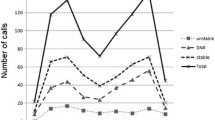Abstract
Background
The Advanced Paramedic (AP) is a relatively recent role in Ireland and refers to a prehospital practitioner with Advanced Life Support (ALS) skills and training. The Advanced Paramedic Clinical Activity Study (APCAS) was initiated to provide an evaluation of the impact of the AP programme on patient care in Ireland.
Aim
The aim of this study is to provide an insight into the clinical activity of APs over a 6-month period in the mid-west region of Ireland.
Methods
A prospective study was initiated whereby all ambulance calls dispatched by the regional Ambulance Control Centre were recorded by the attending AP, including calls received via the statutory 999/112 system. Participating APs were asked to complete a separate call log data sheet recording all demographic and clinical information for every call attended during the study period.
Results
A total of 17 APs participated and 1,969 ambulance calls were recorded in APCAS. The Mid-Western Regional Hospital, Limerick was the busiest receiving facility. Activity peaked at weekends and was lowest on Tuesdays. Crew response, on-scene times and transport times agree with previous reports. Most common emergencies include medical (12 %), cardiovascular (10 %) and altered level of consciousness and seizures (10 %). Least common calls include airway and ventilation and environmental emergencies (<1 %).
Conclusions
This study provides an insight into the work of APs in the mid-west region of Ireland. It would appear that despite the relative recency of the Irish AP programme, the findings of this study are in line with previous international studies.




Similar content being viewed by others
References
National Academy on Sciences (1966) Accidental death and disability: the neglected disease of modern society. National Academy on Health Sciences, Washington D.C
Health Service Executive (2011) Performance report on the National Service Plan (NSP). Health Service Executive, Dublin
Pre-Hospital Emergency Care Council (2012) www.phecc.ie
Pre-hospital Emergency Care Council PHECC Education and Training Standards (2011). Prehospital Emergency Care Council, Naas
Bakalos G, Mamali M, Komninos C et al (2011) Advanced life support versus basic life support in the pre-hospital setting: a meta-analysis. Resuscitation 82:1130–1137
Bury G, Janes D, Bourke M et al (2007) The advanced paramedic internship: an important clinical learning opportunity. Resuscitation 73:425–429
Health Service Executive (2012) www.hse.ie
Ordnance Survey Ireland (2012) www.osi.ie
Central Statistics Office (2011) This is Ireland (Part 1), in Census. The Stationary Office, Dublin
O’Donnell C (2012) Advanced Paramedic Deployment. Limerick
Pre-Hospital Emergency Care Council (2010) Demand Analysis and Tactical Deployment of Ambulance Services in the National Ambulance Service Mid-Western Region. Health Service Executive, Naas
Peacock PJ, Peacock JL, Victor CR et al (2005) Changes in the emergency workload of the London Ambulance Service between 1989 and 1999. Emerg Med J 22:56–59
Román MI, de Miguel AG, Garrido PC et al (2005) Epidemiologic intervention framework of a prehospital emergency medical service. Prehosp Emerg Care 9:344–354
Colman J (2008) Auditor general for wales follow up review—ambulance services in wales. Wales Audit Office, Cardiff
British Association for Immediate Care (2012) www.basics.org.uk
Nicholl J, Coleman P, Parry G et al (1999) Emergency priority dispatch systems—a new era in the provision of ambulance services in the UK. Pre-hosp Immed Care 3:71–75
Health Information and Quality Authority (2011) Pre-hospital emergency care key performance indicators for emergency response times. Health Information and Quality Authority, Dublin
Breen N, Woods J, Bury G et al (2000) A national census of ambulance response times to emergency calls in Ireland. J Accid Emerg Med 17:392–395
Smith RM, Conn AK (2009) Prehospital care—scoop and run or stay and play? Injury 40:S23–S26
Kelly AM, Currell A (2002) Do ambulance crews with one advanced paramedic skills officer have longer scene times than crews with two? Emerg Med J 19:152–154
Shaw D, Dyas JV, Middlemass J et al (2006) Are they really refusing to travel? A qualitative study of prehospital records. BMC Emerg Med 19:8
Acknowledgments
The authors would like to sincerely acknowledge the assistance of all the APs who participated in the study. The authors also gratefully acknowledge the funding of the Pre-Hospital Emergency Care Council (PHECC).
Conflict of interest
None.
Author information
Authors and Affiliations
Corresponding author
Rights and permissions
About this article
Cite this article
Cummins, N.M., Garavan, C., Dixon, M. et al. The Advanced Paramedic Clinical Activity Study (APCAS): an insight into the work of advanced paramedics in the mid-west of Ireland. Ir J Med Sci 182, 469–475 (2013). https://doi.org/10.1007/s11845-013-0915-0
Received:
Accepted:
Published:
Issue Date:
DOI: https://doi.org/10.1007/s11845-013-0915-0




